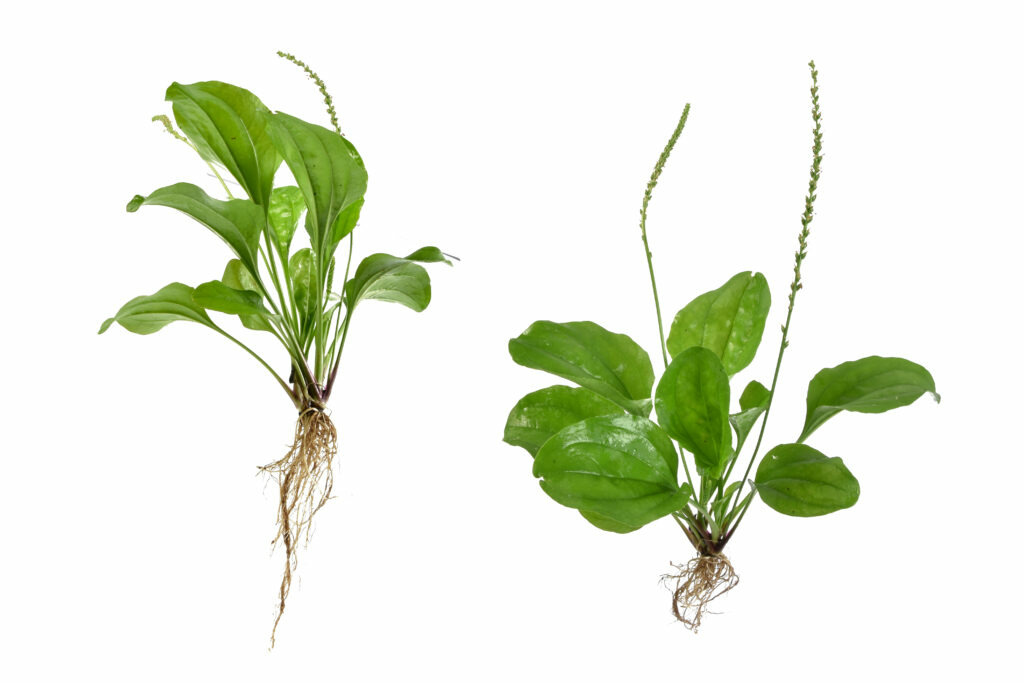
What is it? Its traditional use?
Plantago major is a flowering plant which is native to Eurasia and now has an almost worldwide distribution. It has been used in folk medicine for centuries, and its medicinal benefits have long been acknowledged (Samuelsen, 2000). It is however only in the last twenty years or so, that scientific research has began to quantify and study this.
The plant is made up of phytochemicals including flavonoids and alkaloids, along with fatty acids, polysaccharides and vitamins; each of which are thought to be key elements in its therapeutic effect. In folk medicine it has been used both topically and ingested to treat a range of ailments. The plant leaves have been traditionally used to promote the healing of wounds, burns and insect bites. Additionally, it has also been used to treat respiratory and digestive diseases. It is also thought to have anti-cancer properties, as well as being used for pain relief and to treat infection (Samuelsen, 2000)
What the research says
1. In Vitro experiments
Some in vitro experiments have isolated phytochemicals from the plant to investigate their potential individual roles. In one study the flavonoid aucubin, extracted from plantago m. was found to be a highly active compound. It demonstrated both anti-inflammatory and antioxidant effects (Zeng et.al, 2020).
Another study found that aucubin extracted from the plant had anti-microbial effects. Findings showed it was effective against numerous strains of both gram positive and negative bacteria strains(Özkan et al., 2012; Sharifa et al., 2008; Abd Razik et al., 2012). Aucubin taken from the plant is likely an effective anti-fungal; one study found it effective again biofilm production of the common strain Candida albicans (Shirley et al, 2015).
Research also supports that the plant has anti-viral properties- one study using a hot water extract (Chiang et al, 2002) and another using phytochemicals extracted from it (Chiang et al, 2003). It was found that caffeic acid and chlorogenic acid showed strong activity against a broad spectrum of viruses (Chiang et al, 2003).
2. Clinical Studies- Topical Use
Application of Plantago major topically has been shown to accelerate the healing of wounds, burns and ulcers. The healing of burns on rats were significantly improved with use of a 50% Plantago major topical ointment. It has been suggested that it could be a suitable replacement for silver sulfadiazine, a commonly used product for patients with skin infections arising from burns (Amini et.al, 2010). A randomised blind clinical trial found that topical treatment of Plantago significantly improved the healing of pressure ulcers; 96% compared to 73% in the control group recovered after 2 weeks (Ghiasian et. al 2021). Another key finding in this study showed no side effects from using this treatment. Similarly, a clinical study testing topical gel resulted in a significant reduction in wound sizes of diabetic foot ulcers and pressure ulcers, compared to control groups (Ghanadian et. al, 2022). Studies also indicate the plant extract acts an anti-inflammatory and analgesic (Núñez Guillén et al., 1997)
It is not surprising that this plant has been used in folk medicine for centuries, given the wealth of emerging research to support its medicinal properties. Research has shown no side effects of its use, proven its antimicrobial and anti-inflammatory properties, and also its ability to accelerate wound healing in human and animal studies. It therefore shows great promise as a holistic complementary treatment to wound healing.
References
1 Abd Razik, B.M., Hasan, H.A. and Murtadha, M.K. (2012) “The Study of Antibacterial Activity of Plantago Major and Ceratonia Siliqua ,” The Study of Antibacterial Activity of Plantago Major and Ceratonia Siliqua, 11(`1), pp. 130–135.
2 Amini, M. et al. (2010) “Effect of plantago majoron burn wound healing in rat,” Journal of Applied Animal Research, 37(1), pp. 53–56. Available at: https://doi.org/10.1080/09712119.2010.9707093.
3 Chiang, L.C. et al. (2002) “Antiviral activity of plantago major extracts and related compounds in vitro,” Antiviral Research, 55(1), pp. 53–62. Available at: https://doi.org/10.1016/s0166-3542(02)00007-4.
4 Chiang, L.C. et al. (2003) In Vitro Cytotoxic, Antiviral and Immunomodulatory Effects of Plantago major and Plantago asiatica, 31(2), pp. 225–234. Available at: https://doi.org/10.1142/S0192415X03000874.
5 Ghanadian, M. et al. (2022) “The effect of plantago major hydroalcoholic extract on the healing of diabetic foot and pressure ulcers: A randomized open-label controlled clinical trial,” The International Journal of Lower Extremity Wounds, p. 153473462110707. Available at: https://doi.org/10.1177/15347346211070723.
6 Ghiasian, M. et al. (2021) “Clinical and phytochemical studies of Plantago major in pressure ulcer treatment: A randomized controlled trial,” Complementary Therapies in Clinical Practice, 43, p. 101325. Available at: https://doi.org/10.1016/j.ctcp.2021.101325.
7 Núñez Guillén, M.E. et al. (1997) “Analgesic and anti-inflammatory activities of the aqueous extract of plantago major L.,” International Journal of Pharmacognosy, 35(2), pp. 99–104. Available at: https://doi.org/10.1076/phbi.35.2.99.13288.
8 Samuelsen, A.B. (2000) “The traditional uses, chemical constituents and biological activities of plantago major L. A Review,” Journal of Ethnopharmacology, 71(1-2), pp. 1–21. Available at: https://doi.org/10.1016/s0378-8741(00)00212-9.
9 Sharifa, A.A. et al. (2008) “Effects of Methanol, Ethanol and Aqueous Extract of Plantago major on Gram Positive Bacteria, Gram Negative Bacteria and Yeast,” ANNALS OF MICROSCOPY, 8, pp. 42–44.
10 Shirley, K.P. et al. (2015) “In vitro effects ofplantago major extract, Aucubin, and Baicalein on candida albicans biofilm formation, metabolic activity, and cell surface hydrophobicity,” Journal of Prosthodontics, 26(6), pp. 508–515. Available at: https://doi.org/10.1111/jopr.12411.
11 Zeng, X., Guo, F. and Ouyang, D. (2020) “A review of the Pharmacology and Toxicology of Aucubin,” Fitoterapia, 140, p. 104443. Available at: https://doi.org/10.1016/j.fitote.2019.104443.
12 ÖZKAN, O., METİNER, K. and AK, S. (2012) “Antibacterial effects of ethanol and acetone extract of plantago major l. on gram positive and gram-negative bacteria,” Kafkas Universitesi Veteriner Fakultesi Dergisi [Preprint]. Available at: https://doi.org/10.9775/kvfd.2011.5824.
